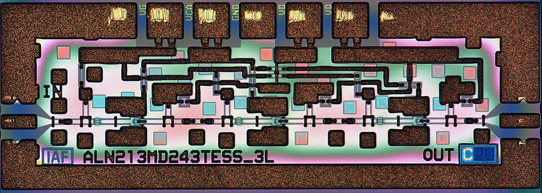News: Microelectronics
20 January 2020
Fraunhofer IAF reports record 640GHz InGaAs MOSHEMT transistors
The Fraunhofer Institute for Applied Solid State Physics (IAF) in Freiburg, Germany has developed a metal-oxide-semiconductor high-electron-mobility transistor (MOS-HEMT) — replacing the Schottky barrier of a conventional indium gallium arsenide (InGaAs)-channel HEMT with an isolating oxide layer (enabling smaller and more powerful devices) — that achieves a record cut-off frequency of 640GHz.
In recent years, the high-frequency characteristics of HEMTs have been steadily improved, becoming faster by downscaling the gate length to 20nm. However, at such small structure sizes, HEMTs encounter problems: the thinner the indium aluminum arsenide (InAlAs) barrier material becomes, the more electrons leak from the current-carrying channel through the gate. These unwanted gate leakage currents have a negative impact on the efficiency and durability of the transistor, which renders further downscaling attempts impossible. The existing transistor geometry of a conventional HEMT has reached its scaling limit. Silicon metal-oxide-semiconductor field-effect transistors (MOSFETs) are no stranger to this problem either. However, they have an oxide layer that can prevent unwanted leakage currents for longer than is the case with HEMTs.
Combining advantages of both transistor technologies
Combining the advantages of III-V semiconductors and silicon MOSFETs by replacing the Schottky barrier of a HEMT with an isolating oxide layer yields a “device which has the potential to exceed the efficiency of current HEMTs by far,” says Dr Arnulf Leuther, a researcher in high-frequency electronics at Fraunhofer IAF. “The MOSHEMT allows us to downscale it even further, thus making it faster and more efficient,” he adds. With the MOSHEMT technology, Leuther and his team have succeeded in achieving a record maximum oscillation frequency of 640GHz. “This surpasses the global state of the art for any MOSFET technology, including silicon MOSFETs,” says Leuther.
High barrier to overcome leakage currents
To overcome the gate leakage currents, the researchers had to use a material with a significantly higher barrier than the conventional Schottky barrier. They therefore replaced the semiconductor barrier material with a combination of isolating layers consisting of aluminum oxide (Al2O3) and hafnium oxide (HfO2). “This enables us to reduce the gate leakage current by a factor of more than 1000,” says Fraunhofer IAF researcher Dr Axel Tessmann. “Our first MOSHEMTs show a very high development potential, while current field-effect transistor technologies have already reached their limit.”
First integrated circuit with MOSHEMTs

Picture: MOSHEMT-based amplifier circuit, operating at 243GHz.
The extremely fast MOSHEMT is designed for the frequency range above 100GHz and is therefore especially promising for novel communication, radar and sensor applications. In the future, high-power devices should ensure faster data transmission between radio towers and enable imaging radar systems for autonomous driving as well as higher resolution and precision of sensor systems. Fraunhofer IAF says that, while it will take some years until the MOSHEMT finds its way into commercial application, it has already succeeded in realizing what it claims is the first monolithic microwave integrated circuit (MMIC) amplifier based on InGaAs MOSHEMTs for the frequency range 200-300GHz.








